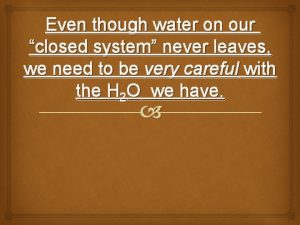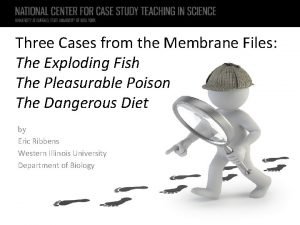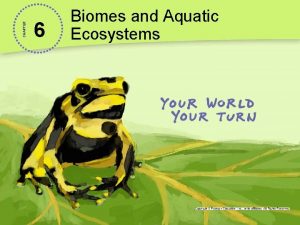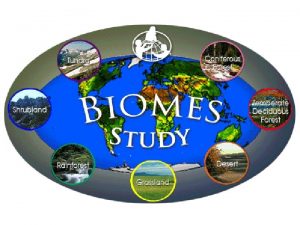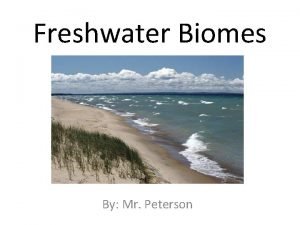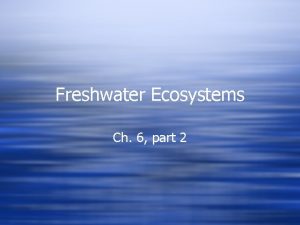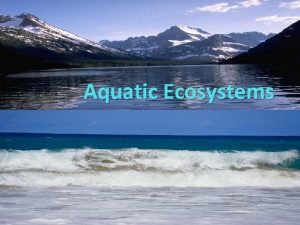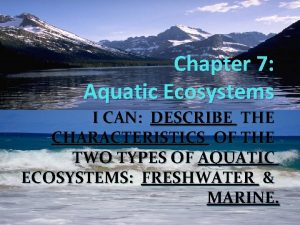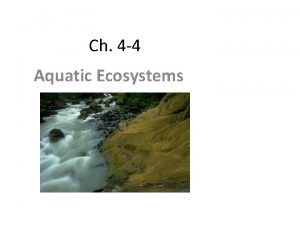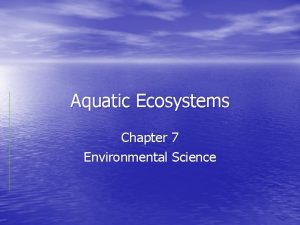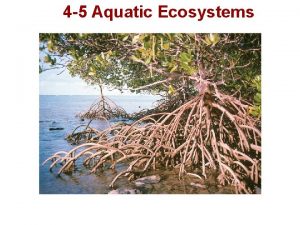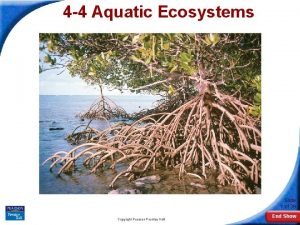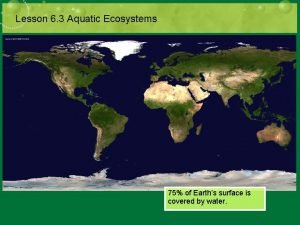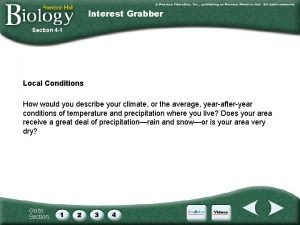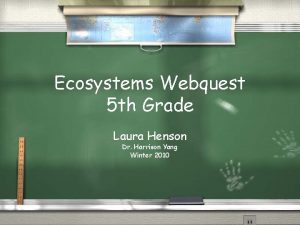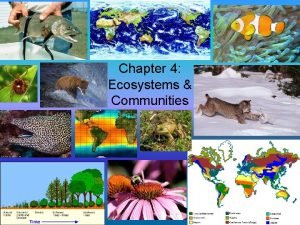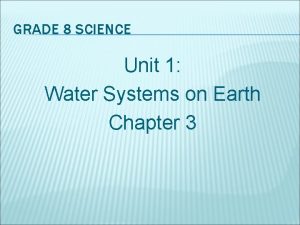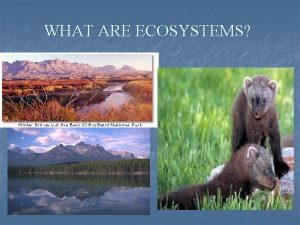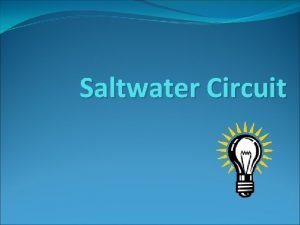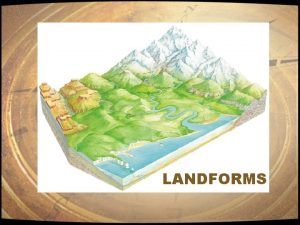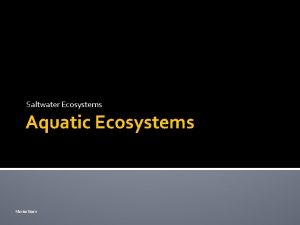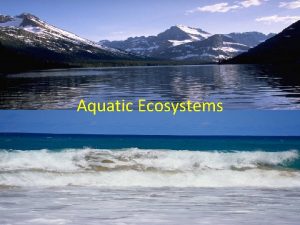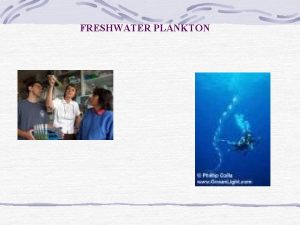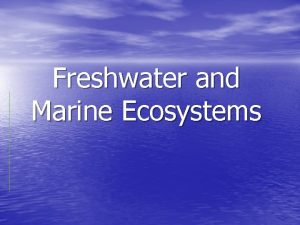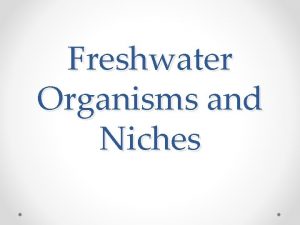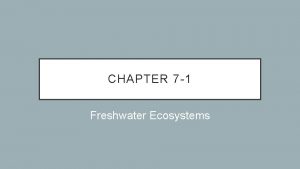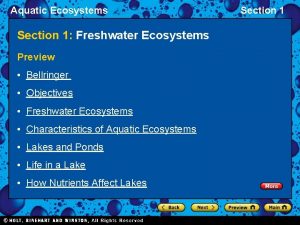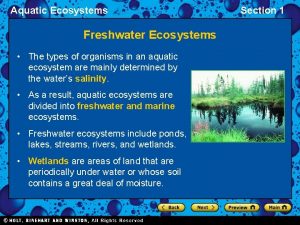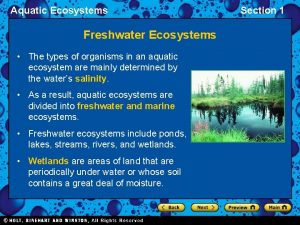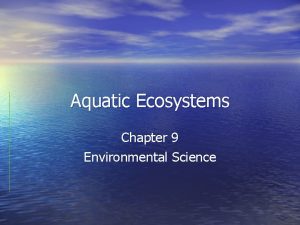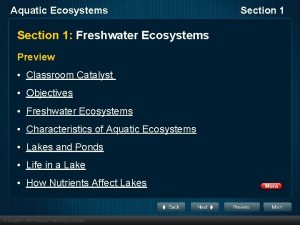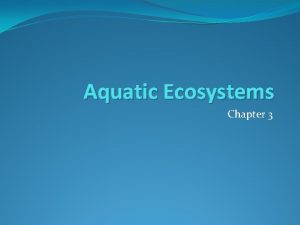Freshwater and Saltwater Systems Living in Aquatic Ecosystems





























- Slides: 29

Freshwater and Saltwater Systems

Living in Aquatic Ecosystems • An adaptation is a physical characteristic or behavior of a species. • An adaptation increases the species’ chances of survival in a particular environment • Aquatic species have adaptations that help them to breathe, feed, move and reproduce in water.

Factors that Influence Adaptations • • • Temperature Light Pressure Salinity Water Movement

Temperatures • Plants and animals have adapted to the temperature of the water that they live in • Mammals that live in cold water have thick layers of fat to keep them warm • Fish are cold blooded which means that their internal temperature is controlled by the temperature of the water around them

Light • Most plants and animals that live in the water live in the euphotic zone. • In deep water, some animals use bioluminescence • Plants need light to photosynthesize

Pressure • The deeper in the water you go, the greater the water pressure is. • https: //www. youtube. com/watch? v=U 69 LIr 0 Or. Nc Noteworthy Creatures in the Ocean Depths

Salinity • The amount of salt in a body of water determines what types of organisms can exist in it. • If the water is salty, animals and plants must be able to rid their cells if extra salt or prevent it from entering their cells. • Some organisms can live in both salt and fresh water environments. – Fresh water sharks and salmon

Water Movement • Fish, plants and mammals use the powerful ocean currents to help them travel or feed. • Other stationary organisms depend on ocean currents to bring them food. – Need to have adaptions that allow them to anchor themselves to rocks and other fixed objects. Or digging into the sand

WATERSHEDS AND CLEANING WATER

Water, Water Everywhere… • • • Water is the key to life – scientists believe that life cannot exist without it! More species of organisms inhabit the water than any other place on Earth Whether you realize it or not, you depend on water every moment of your life How did we get fresh water? https: //www. youtube. com/watch? v=Rwt. O 04 EXg. UE

Earth is called the ‘blue planet” because 74% of the surface is covered by water. The hydrosphere is the area of Earth and its atmosphere water (and life) is present.

THINK ABOUT IT! What are some ways you depend on water? What would happen if you didn’t drink water? https: //www. youtube. com/watch? v=9 i. MGFq. M m. UFs

How do you depend on water? • About 65% of your body mass is water • In comparison, an apple is about 84% water and a watermelon is about 98% water • Every breath you exhale has water vapor in it • Every cellular process uses a tiny fraction of your body’s water • To maintain a normal body temperature of 37 degrees Celsius you need to sweat and release water • You lose water every time you eliminate wastes as well • You need to consume about 2. 5 L of water each day

TYPES OF WATER • Salt water – water such as ocean water and seawater that has a high salt content • 97% of the earth’s water is salt water – not drinkable (Drinkable water = POTABLE) (Not Drinkable = NON-POTABLE)

Oceans and Seas • Oceans and seas cover 75% of Earth’s surface and contain about 97% of the world’s water • Ocean water is made up of about 3% salt and about 1% other elements such as gold, fluoride, magnesium, calcium and potassium • The measure of the amount of salts present in a given amount of a fluid is called salinity.

Oceans • The ocean covers approximately 72% of Earth’s total surface area and is one continuous body of salt water • Circle the Names of the Oceans – there will be 5! • How Big Is the Ocean? • https: //www. youtube. com/watch? v=QUW_Zv _j. Jb 8&t=29 s

Fresh water – water that most organisms can drink or use for life functions such as lake water, river water, pond water or well water.

In reality only 0. 3% of the Earth’s water is useable by humans!

Who has the water? • Four countries hold almost half of the Earth’s renewable supply of freshwater: * Brazil 18% * China 9% * Canada 9% * United States 8% • Most of our water is used to feed us! – 73% Agricultural Use – 22% Industrial Use – 5% Domestic Use (including drinking)

Watersheds • The area of land that drains into a body of water • Upstream areas or start of watershed is called HEADWATERS • Downstream areas or end of watershed is called OUTFLOW

The Watershed Concept • No matter where a raindrop falls, it will eventually end up somewhere else • All water on Earth – either surface water or groundwater – is part of a watershed. • A watershed, or drainage basin, is the area of land that drains a body of water, such as a river, pond, wetland, lake or ocean. • Water hits the ground and either filters into the groundwater or flows downhill

• Water that doesn’t soak into the ground or evaporate, but flows across the Earth’s surface is called run-off • In North America, a continuous ridge of mountain ranges divides the continent into two main drainage areas • This ridge of mountains is known as the Continental Divide.

Watersheds (cont. ) • Landforms determine the size of a watershed. • High ground such as mountains, hills, etc. direct water one way or another

Water in Canada • Canada has 5 major watersheds (drainage basins) • • • Pacific Ocean Arctic Ocean Gulf of Mexico Hudson Bay Atlantic Ocean

• Colour the Basins in

Cleaning Water • water is purified in nature by the hydrological cycle → when water evaporates it leaves behind dissolved compounds… and then rain water is of better quality

Producing Freshwater • https: //www. youtube. com/watch? v=otrpxt. A m. DAk • How does the UAE get their water? • https: //www. youtube. com/watch? v=d 0 jdlh. NC gc 4

Producing Freshwater • Distillation – water is boiled in a container – evaporating water leaves impurities behind – the resulting water vapor is collected, allowed to condense, producing clean distilled water • Reverse osmosis – pressurized salt water is pushed through a semi permeable membrane which filters out the salt and other minerals • Desalinization – Combination of reverse osmosis and filtration

Cleaning Water Demonstration • How do filters clean water? Draw and describe the filtration system made in class. • Think about it! Would filters help with having clean water globally? What are some other concerns we may have globally?
 Pie chart of freshwater and saltwater
Pie chart of freshwater and saltwater Saltwater fish in freshwater explode
Saltwater fish in freshwater explode The chaparral biome is best characterized by _______.
The chaparral biome is best characterized by _______. 6 biomes and aquatic ecosystems answers
6 biomes and aquatic ecosystems answers Chapter 3 lesson 3 biomes and aquatic ecosystems
Chapter 3 lesson 3 biomes and aquatic ecosystems Aquatic vs terrestrial
Aquatic vs terrestrial Biomes and aquatic ecosystems
Biomes and aquatic ecosystems Freshwater biomes facts
Freshwater biomes facts Lentic ecosystem
Lentic ecosystem Describe freshwater
Describe freshwater Temperate region
Temperate region Lesson outline lesson 2 aquatic ecosystems answer key
Lesson outline lesson 2 aquatic ecosystems answer key Transitional aquatic ecosystems
Transitional aquatic ecosystems Marine ecosystem webquest
Marine ecosystem webquest Section 4-4 aquatic ecosystems
Section 4-4 aquatic ecosystems What factors describe aquatic ecosystems
What factors describe aquatic ecosystems Chapter 7 environmental science
Chapter 7 environmental science 4-4 aquatic ecosystems
4-4 aquatic ecosystems 4-4 aquatic ecosystems answer key
4-4 aquatic ecosystems answer key Chapter 7 aquatic ecosystems test answers
Chapter 7 aquatic ecosystems test answers Lesson 3: aquatic ecosystems
Lesson 3: aquatic ecosystems Interest grabber
Interest grabber Ecosystem webquest 5th grade
Ecosystem webquest 5th grade Section 4-4 aquatic ecosystems
Section 4-4 aquatic ecosystems Mr collinson grade 8 water systems
Mr collinson grade 8 water systems Non living things in grasslands
Non living things in grasslands Terrestrial food production
Terrestrial food production Describe how the saltwater circuit works
Describe how the saltwater circuit works Is the hudson bay saltwater
Is the hudson bay saltwater Saltwater round fish
Saltwater round fish
